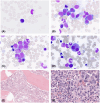Diagnostic features in paediatric MDS-EB with UBTF-internal tandem duplication: defining a unique subgroup
- PMID: 39564724
- PMCID: PMC11791721
- DOI: 10.1111/his.15378
Diagnostic features in paediatric MDS-EB with UBTF-internal tandem duplication: defining a unique subgroup
Abstract
Aim: Tandem-duplications of the UBTF gene (UBTF-TDs) have recently been identified as a new genetic driver in young individuals with acute myeloid leukaemia (AML) and myelodysplastic syndrome (MDS). Disease in these newly defined subgroups is characterized by poor response to standard intensive chemotherapy and inferior survival of the affected patients. However, a thorough analysis of bone marrow histomorphology of UBTF-mutated neoplasia has not been undertaken thus far.
Methods and results: In this retrospective study, we investigated the characteristic histopathological features of a cohort comprising 14 paediatric MDS patients with an excess of blasts (MDS-EB) and UBTF-TD. Bone marrow biopsies from these patients revealed hypercellularity and severe dysplasia across all three haematopoietic lineages. In particular, a marked hyperplastic megakaryopoiesis characterized by the presence of frequent micromegakaryocytes and a high number of monolobulated cells forming small clusters was observed. Additionally, erythropoiesis was left-shifted, with numerous blastoid precursors. The granulopoietic precursors displayed prominent UBTF-positive nucleoli.
Conclusion: The unique combination of these histomorphological features strongly suggests a possible UBTF aberration. It will allow initiating the appropriate genetic testing to confirm the presence of UBTF-TD and identify potential additional genetic alterations. Such molecular profiling will not only contribute to a better understanding of the disease mechanism, but also facilitate more rational treatment approaches for these high-risk paediatric MDS patients.
Keywords: UBTF‐TD; diagnostic features; paediatric MDS.
© 2024 The Author(s). Histopathology published by John Wiley & Sons Ltd.
Conflict of interest statement
The authors declare no conflicts of interest.
Figures



References
-
- Kaburagi T, Shiba N, Yamato G et al. UBTF‐internal tandem duplication as a novel poor prognostic factor in pediatric acute myeloid leukemia. Genes Chromosomes Cancer 2023; 62; 202–209. - PubMed
MeSH terms
Substances
LinkOut - more resources
Full Text Sources
Medical
Research Materials
Miscellaneous

